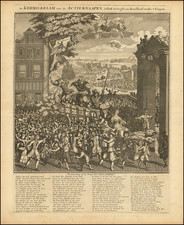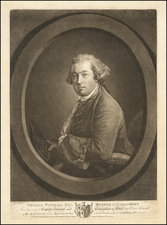Native American Portrait after Paul Kane
Chief of the Skeen
This captivating watercolor, executed circa 1860s, depicts Mancemuckt, a distinguished Native American figure who was Chief of the Indians of the Dalles of the Columbia River, also known as the "Chief of the Skeen." It is almost certainly after a chromolithograph by Paul Kane, which served as an illustration in this book, Wanderings of an artist among the Indians of North America : from Canada to Vancouver’s Island and Oregon, through the Hudson’s Bay company’s territory and back again (1859). While not the work of the artist himself, this period copy is very nicely finished and retains its own allure as a period work.
Mancemuckt is represented here as a dignified and commanding presence as he dons a distinctive fox-skin cap and a leather deerskin shirt, emblematic of his tribal affiliation and leadership. The artwork captures the essence of this notable leader, belonging to the Skinpah people, a Sahaptin group that resided along the northern bank of the Columbia River in present-day south-central Washington. Initially encountered as the "Eneeshurs" by the famous explorers Lewis and Clark in 1805, the Skinpah were subsequently known as the "Skeen," as evidenced in an 1847 painting by Paul Kane titled "Mancemuckt, Chief of the Skeen."
This watercolor holds a deeper historical significance tied to the complex interplay between Native populations and white settlers in the region. The late 1840s witnessed escalating conflicts, culminating in the Cayuse War, which erupted in 1847. In response to these hostilities, the U.S. government established Fort Dalles in 1850, strategically positioned to safeguard American travelers en route to the Oregon Trail. The discovery of gold in Oregon and eastern Washington during the early 1850s further transformed The Dalles into a vital link connecting mining regions with Portland. Steamboats plied the river, transporting miners, supplies, and the precious metal downstream from The Dalles, while passengers, manufactured goods, and essential resources flowed upstream from Portland.
By 1855, territorial and U.S. government authorities coerced local tribes into signing treaties that relinquished their lands, leading to their removal to reservations. However, these agreements failed to alleviate mounting tensions, ultimately igniting the Yakama War. Fort Dalles assumed a central role as the military headquarters for deploying federal troops to engage in battle. Against this backdrop of upheaval and conflict, this watercolor serves as a visual link to a tumultuous era, marked by profound struggles and poignant life histories that shaped the landscape of the Columbia River region.
The original watercolor sketch for this portrait, dated 1847 and signed by Kane, measures 5 5/8 x 4 inches, and is currently at the Stark Museum of Art in Orange, Texas. The larger portrait (2 feet x 1' 8"), which likely served as the basis for the chromolithograph in Kane's book, is described in a catalogue of Kane's paintings, Catalogue of Pictures of Indians and Indian Life by Paul Kane (ca. 1920), entry 75. The artist-author was born in Toronto (then called York) in 1810. After extensive artistic training in the art centers of Europe he returned to Toronto in 1845 and spent several years among various Native tribes in Canada and Northwestern North America. He traveled to England in 1857 to prepare the illustrations for his book. He was planning further publications but his failing eyesight preventing him from completing additional projects.
The present watercolor meticulously captures dignity of Chief Mancemuckt, the Skinpah people and the enduring legacy and intricate tapestry of Native American history in the Dalles of the Columbia River.












![(Mexican-Aztec Paintings) Facsimile, page 19 of an original [Mex]ican painting of Sir Thomas Bodley's collection [in the Bod]leian Library, Oxford, [Aglio's] Antiquities, vol. 1](https://storage.googleapis.com/raremaps/img/small/102328.jpg)
![[Jonah Negotiating His Embarkation] Quid demens latebras circumspicis alterum in orbem. Si fugirs Dominum, non tamen effugies. Cui tellus paret, summus cui militat aether, Non parere putas huic etiam Oceanum](https://storage.googleapis.com/raremaps/img/small/85070.jpg)
![(Mississippi Bubble) Kermis Wind-Kraamer En Grossier [Fair of the wholesale wind-pedlar.]](https://storage.googleapis.com/raremaps/img/small/95945.jpg)

![[Portrait] L'Asie.](https://storage.googleapis.com/raremaps/img/small/79746.jpg)